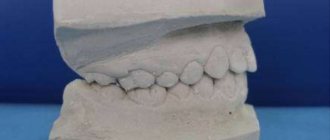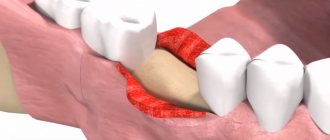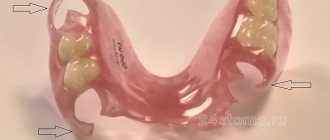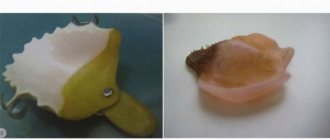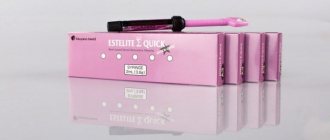1112
Ribbon was created in 1992 to help orthodontists.
The product is a strip of varying widths made of acrylic fiber that is easy to combine with the adhesive materials used.
The main task of the product is to reliably fasten and hold teeth during splinting.
Varieties and equipment
Ribbond dental products are differentiated according to the following criteria:
- The standard tape is 0.35 mm thick. It is presented in a blue box and marked in blue.
- Ultra tape name due to its ultra-thin base of 0.12 mm. Increased adaptive properties when in the oral cavity characterize this type of line. The silver box contains a 22cm section.
- The tape with a complex weave , 0.18 mm thick, is packed in a golden box. Features increased flexibility.
Ribbon strips are sold in kits that include the tools and materials necessary for the job.
Indications for intrapulpal anesthesia in dentistry, pros and cons of the anesthesia method.
Read here about the purpose of Neoconus in dentistry.
At this address https://www.vash-dentist.ru/lechenie/zubyi/chto-takoe-endodonticheskoe.html learn more about the endodontic treatment of temporary teeth.
Standard set
The standard (starter) set consists of:
- Specially designed scissors capable of cutting fiberglass strip;
- Soft foil necessary for determining the size and length of the segments;
- 22 cm standard tapes in the amount of 3 pieces. The widths are 2mm, 3mm and 4mm.
- Ribbons with complex weaving, width 1 mm and 7 mm. A thin tape is designed to fix an orthodontic retainer (a metal arch used to secure the result obtained when wearing braces).
- Instructions for using the above tools:
The kit for further replenishment includes:
- Tapes with a choice of width (2 mm; 3 mm; 4 mm) with a length of 22 cm in the amount of 3 pieces, or 1 tape of the required width, which is 68 centimeters.
- Soft foil.
- Periodically updated instructions for use.
Material properties
Features of the fiber used in Ribbond products are:
- The patented weaving of acrylic fibers consists of multi-directional threads.
This method is called the lockstitch cross stitch. Such weaving prevents cracking of the structure. Another advantage of weaving is the impossibility of threads sticking together; - compatibility with soft tissues and the oral cavity is the inability to injure the inside of the oral cavity with the raw ends of the tape;
- the absence of shape memory helps to carefully apply and secure the material to the tooth surface. Ribbon acts as a strong fastening for splinting and prosthetics.
Fiberglass thread in teeth splinting
Among the materials used for splinting, dentists most often use fiberglass thread. The popularity of this splinting method is due to its reliability and reasonable cost. The aesthetics of the method also played a significant role in the frequency of use of fiberglass thread.
Splinting mobile teeth with fiberglass
The thread, after its installation in the required place of the dentition, is almost invisible, since its shade is similar to the color of the enamel. The procedure is carried out quickly, with local anesthesia. The thread is placed into small indentations made by the doctor on the inside of each incisor. The recesses are then filled with composite material.
When laying the thread, it should not only be laid along the loose incisors, but also the supporting canines. They take on the bulk of the load during the chewing process. After splinting is completed, the incisors are firmly connected, becoming motionless. Even if food is bitten off with only one incisor, the load from this action is distributed evenly over the entire row of teeth held together with thread.
Adhesive splinting of teeth
Advantages and disadvantages
Orthodontists highlight the following advantages of Ribbond tapes:
- Guaranteed strength due to the material, which is high molecular weight polyethylene (fiberglass). The tape undergoes mandatory plasma treatment, which significantly increases the durability of the product.
- Ease of use has made Ribbond a recognized favorite among dentists.
The ends remain tightly woven even when cutting, which allows you to attach the strip efficiently and tightly. To work with Ribbond, you need scissors and adhesives. No other specific tools are required. - The unique weaving technique guarantees the prevention of loss of shape, stretching, or cracking of the tape during use.
- The aesthetic appearance lies in the transparency of the material. The ribbon is almost invisible on the teeth.
- The tape is used in dental and orthodontic operations. The scope of Ribbond is extensive.
- Universal binding properties allow Ribbon to be used with various composite materials.
- An acceptable cost distinguishes Ribbond from fixed metal prostheses.
- Upon completion of treatment, the tape is removed from the tooth surface easily and painlessly.
Among the disadvantages of the tape, patients note difficult dental hygiene in the area where the strips are attached. Such a deficiency can cause caries.
Useful tips
When using Ribbond tapes, you must use enamel bond that does not contain filler as an adhesive.
Attention. To wet Ribbond, you cannot use one-component dentin-enamel adhesives, bonds with fillers, as well as self-etching adhesives and flowable composites.
The latter are not sticky enough to hold the tape in place before polymerization. Liquid-flowing composites should be used as a finishing (third) layer to hide the Ribbond fibers. Their application replaces polishing, which is not recommended for high molecular weight polyethylene fibers.
The following materials can be used as adhesives and composites.
- Bonds – Scotch Bond and Multi-purpose Adhesive (3M), Optibond (Kerr), Permaseal (Ultradent).
- Composites – Z-250 and Filtek Supreme (3M), Herculite (Kerr), Amelogeon (Ultradent).
- Flowable composites – Filtek Flow (3M), Porcelite or Nexus (Kerr), Permaflow (Ultradent).
Areas of application
The use of Ribbond strips is recommended in the following cases:
- the need to fix the dentition in case of injury and violation of the integrity of the teeth;
- fortification of composite materials;
- splinting to minimize dental mobility;
- maintaining results after removing braces (using Ribbond as a retainer);
- completion of endodontic treatment using tape as a support for dentures;
- reconstruction of a tooth with splitting syndrome;
- bridge prosthetics.
Treatment tactics for tooth infection and techniques used.
In this publication we will talk about the features of the depophoresis apparatus.
Follow the link https://www.vash-dentist.ru/lechenie/zubyi/kogda-trebuetsya-perelechivanie.html to find out why a tooth hurts after retreatment.
Splinting of teeth as a component of the treatment process
In addition to the general treatment of periodontal disease, which uses various anti-inflammatory drugs and antibiotics, dentists often use dental splinting. In this way, loose teeth are strengthened, since splinting reduces the load on them, distributing it to the healthy part of the jaw.
How to splint teeth for periodontal disease
Patients note the advantages of this method of strengthening the dentition immediately after splinting:
- tooth mobility decreases, which significantly reduces the risk of tooth loss;
- the effectiveness of splinting increases if a significant number of teeth are involved in the process;
- The quality of the food chewing process is significantly improved.
Stages of teeth splinting
Instructions for use
The method used by the specialist will directly depend on the specific extent and form of treatment.
Application when applying an orthodontic retainer
Creating a fixation of the dentition after using braces looks like this:
- The surface of the teeth is thoroughly cleaned of plaque and tartar;
- To enhance strength, auxiliary grooves are made; if this is not necessary, then this point is skipped;
- Tooth enamel undergoes an etching procedure, and then an adhesive is applied;
- Then the careful application of the composite composition begins. Interdental spaces require special care;
- Afterwards, the optimal amount of adhesive is applied to the Ribbond and the structure is carefully strengthened on a composite base;
- The excess composite composition is removed from the tooth surface, and the remaining layer is illuminated;
- To ensure the reliability of the retainer, a second layer of composite is added and the illumination process is repeated;
The finished structure is polished.
Splinting for periodontal disease
The teeth on which the splints will be installed are thoroughly cleaned of plaque. The following steps follow:
- The preparation of teeth, i.e. the creation of longitudinal depressions in them, is carried out with the aim of strong adhesion and tight fit of the fiber to the tooth surface.
This operation is necessary for the aesthetic appearance of the structure. However, if the patient refuses to violate the integrity of the tooth, it is advisable to prepare only the outermost elements. This is necessary to protect the ends of the tires from abrasion. - Next, using soft foil, the doctor takes measurements. This way the length of the tire becomes clear.
- The treatment area is separated from the rest of the space in the oral cavity.
- Tooth enamel is etched and bonded.
- The first layer of the composite composition is applied.
- The ribbon also undergoes adhesion.
- The structure is placed on the teeth and carefully fixed.
- Contacts between teeth are adapted. There is a risk of accidentally removing a previously installed tire. To avoid this, you need to hold the secured part of the tire with a tool.
At the end of the procedure, the unnecessary volume of the composite is removed and the splint is finished polished.
The video shows the process of splinting teeth for periodontitis with Ribbond tape.
Manufacturing of bridges
The teeth are processed in the manner described above, then the doctor performs the following algorithm of actions:
- The first part of the composite material is applied to the teeth;
- The ribbon is installed on the teeth along with the bond;
- Excess composite is cleaned out, the composition is illuminated;
- When creating a bridge, another tape is needed. It should also be reinforced with bonding;
- Light polymerization;
- The ends of the Ribbon are firmly fixed with composite material;
After all the steps, the missing fragment is built up from the composite, which must be adjusted to the size of the tooth, shape and bite. The structure is undergoing final polishing.
Use as a pin
First, endodontic root canal treatment is performed.
After the doctor is convinced of the quality of treatment, the following manipulations are carried out:
- The channel is etched from the inside and adhesive is applied there;
- The ribbon is also treated with an adhesive compound;
- The channel is filled with a cementitious substance;
- The tape is embedded inside the canal, but not entirely - its edge should be above the crown;
- A second piece of Ribbond is placed on the dentition and illuminated;
The restored crown regains its previous appearance and position.
Ribbond – restoration on a pin
Educational material: Ribbond – restoration on a pin
Restoring endodontically treated teeth is a major challenge for the restorative dentist. In the past, cast cores and universal metal pins were used to restore teeth, which provided only mechanical retention with the tooth.
These pins did not strengthen the tooth structure in any way. In addition, these materials showed through and darkened the ceramic structures. Today, aesthetic adhesive fixation pins are used for restorations, which strengthen endodontically treated teeth.
To preserve the maximum strength of tooth structures, it is necessary to take an engineering approach to restoring endodontically treated teeth. These principles were described by Dr. Jack Nichols.
The design must be a fail-safe system, and possible failure must occur in the superstructure and not in the tooth. When restoring a tooth, it is necessary to preserve dentin as much as possible, even its thinnest areas. Even these thin areas of dentin provide a strong connection between the tooth root and core, and between the crown and root. Nicholls JI. An engineering approach to the rebuilding of endodontically treated teeth, J Clin Dent, 1:41-44, 1995.
Taking these facts into account, many pioneers of adhesive dentistry, including Hornbrook, Karna, Bartel, Antonson, began to use Ribbond reinforcing fibers when restoring endodontically treated teeth to strengthen the tooth structure.
Retention and anti-rotation (increase at each retention step)
Useful tips
Dentists using Ribbond have determined the optimal conditions for working with tapes:
- Suitable impregnation for strips is unfilled adhesive;
- The basis is a lightly filled composite;
- A flowable composite is required for finishing;
Price
The price of Ribbon varies depending on the choice of set and its components. The most inexpensive set consisting of a standard 22-centimeter tape with a width of 2 mm, instructions for use and soft foil will cost 6,680 rubles.
The most expensive set includes:
- 3 Ribbond THM Ultra tapes 22 cm long, 0.12 mm thick and 2, 3, 4 mm wide;
- specially designed scissors;
- soft foil for preliminary measurement;
- instructions for use in Russian;
- visual instructions.
The cost of this set is 21,575 rubles.
The cost of some dental services using Ribbond reinforcing tape is discussed below:
- Splinting one tooth with Ribbond will cost the patient 1,300 rubles.
- The cost of manufacturing a prosthesis based on composite materials and Ribbon tape is 8,200 rubles per tooth.
- The cost of temporary splinting of 6-8 teeth reaches 8,800 rubles.
Cable-stayed splinting
This method of getting rid of tooth mobility is considered the most effective today. When using it, an aramid thread with the highest strength is used. The installed aramid fibers create a strong connection of the moving teeth along their horizontal lines, which does not cause discomfort.
Cable splinting of teeth
Performing cable-stayed splinting is similar to using fiberglass, but the strength of the structure is much higher. The qualities inherent in aramid thread provide this splinting method with a significant advantage:
- preservation of teeth even with severe mobility. At the same time, there is no risk of atrophy for bone tissue, since the thread ensures the immobility of a row of teeth along the gum;
- small defects in the dentition are closed with floss;
Features of cable-stayed splinting - There is minimal trauma to the teeth, since there is no need to grind them down. The groove machined to accommodate the thread is covered with a composite filling material, so there is no risk of caries;
- cable-stayed splinting can become an alternative to prosthetics - the element replacing the lost tooth is fixed during the splinting process with an aramid thread;
- speed of splinting, which gives a highly aesthetic result for a long time.
After fixation of the AMP, cable splinting of the teeth was performed using an aramid thread.
Reviews
You can leave feedback on the quality level of Ribbond tapes, nuances and ease of use at the end of this article.
Equally important is the opinion of both the orthodontist and the user of the Ribbond reinforcing strips.
If you find an error, please select a piece of text and press Ctrl+Enter.
Tags treatment splinting
Did you like the article? stay tuned
Previous article
In what cases is a disconnecting mouthguard used and the mechanism of action of the device?
Next article
Universal Kollapan and its purpose in dentistry

